-
When you click on links to various merchants on this site and make a purchase, this can result in this site earning a commission. Affiliate programs and affiliations include, but are not limited to, the eBay Partner Network.
-
Posts
10,821 -
Joined
-
Last visited
-
Days Won
17
Content Type
Profiles
Forums
NGC Journals
Gallery
Events
Store
Downloads
Posts posted by BillJones
-
-
Very fascinating history behind those two pieces. Thank you for the lesson.
I wasn't really into history much and in high school/college I would have said it was my "least favorite" subject... Then out of nowhere I catch this sucker-punch from the coin "BUG" and shortly thereafter I find myself wishing I could go back to school and stay awake during history class.. Much like coins, I cant seem to get enough of it.
I am not sure that high school history would have made you happy. For me it was only a start. If you would like a list of books I could post it here, but my response will have to wait for a week. Sadly I am afraid that current high school history is less satisfying. I go for "like is was" not sanitized or PC history.
-
Had Harrison not died, would the Whig Party be one of the Big 2? Or would it have facilitated a 3 party system? 20 years after his death, the party was gone.
I don't think that the Whig Party would have survived regardless of what would have happened had William Henry Harrison survived. The trouble with the Whig Party was that it was more against something than it was for something.
The "something" was Andrew Jackson and his successors. The fundamental problem was the northern half of the party became increasingly anti-slavery while the southern half supported it while many of them were pro-union. That split the party in two in the early 1850s and led to its demise. From the ashes came the Elephant Party which added anti-slavery and pro-union people to its ranks as it grew.
The Donkey Party almost fell apart over slavery, but it survived the Civil War and continued as the "conservative" American party until William Jennings Bryan turned it leftward in 1896.
-
Here is an early, very scarce William Henry Harrison medal from his 1840 presidential campaign. William Henry Harrison won the 1840 Whig Party presidential nomination in December of 1839. On May 4, 1840 the Whigs held a ratification / pep rally convention for Harrison in Baltimore, Maryland. National political conventions were often held in Baltimore in the 19th century because the city was centrally located on the Eastern Seaboard and had an easily accessible harbor. The "young men" aspect was undoubtedly intended to get the young and first time voters energized and enthusiastic for the upcoming campaign.
The 1840 William Henry Harrison presidential run set the standard for the modern political campaign. The Whigs pulled out all the stops with huge rallies, parades, barbeques and other events. At one point the Whigs built a huge ball, with slogans written on it, that was 10 feet in diameter and started to push it from Cleveland, Ohio to Lexington, Kentucky. The idea was to "keep the ball rolling" and get the voters out to polls. It was said the parade behind this ball stretched at one point to nine miles long.
The Whigs also issued a large number of tokens, ribbons and other campaign items. The output exceeded all previous campaigns, and would exceed most all succeeding elections until the landmark 1896 canvass. As a result there are many political medalets with Harrison on the obverse and a long cabin on the reverse. Here is a typical example, listed as WHH 1840-50.
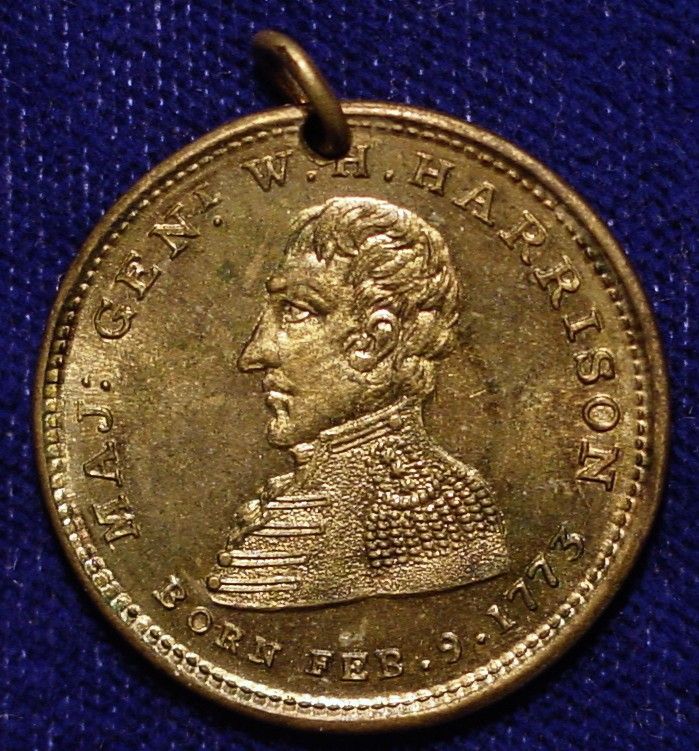

The strategy worked. Harrison won the presidency despite that fact that the Whigs were the minority party and they were running against in incumbent president, Martin Van Buren. The voter turnout also impressive. Eighty-five percent of the eligible voters cast ballots, which is an amazing percentage compared with today's statistics, which usually hover around 50%.
Unfortunately Harrison's presidential campaign was much more exciting that his presidency. On Inauguration Day he stood in the cold and rain without a hat and coat and gave the longest inaugural speech in history. He caught a cold with developed into pneumonia, became progressively weaker and died 30 days after taking office. His vice presidential successor, John Tyler, proved to be more of Jefferson Donkey Party man than a Whig. He vetoed a re-charter for the Bank of the United States, which was the cornerstone of the Whig platform and soon became a president without supporters or a political party.
This piece is listed as WHH 1840-1 in Sullivan / DeWitt. It is a very scarce piece, and represents a significant upgrade from me. If anyone has an interest in my old one, which grades VF, send me a PM. I'll warn you these pieces are not cheap. My guess is there are no more than 20 of these pieces still in existence.
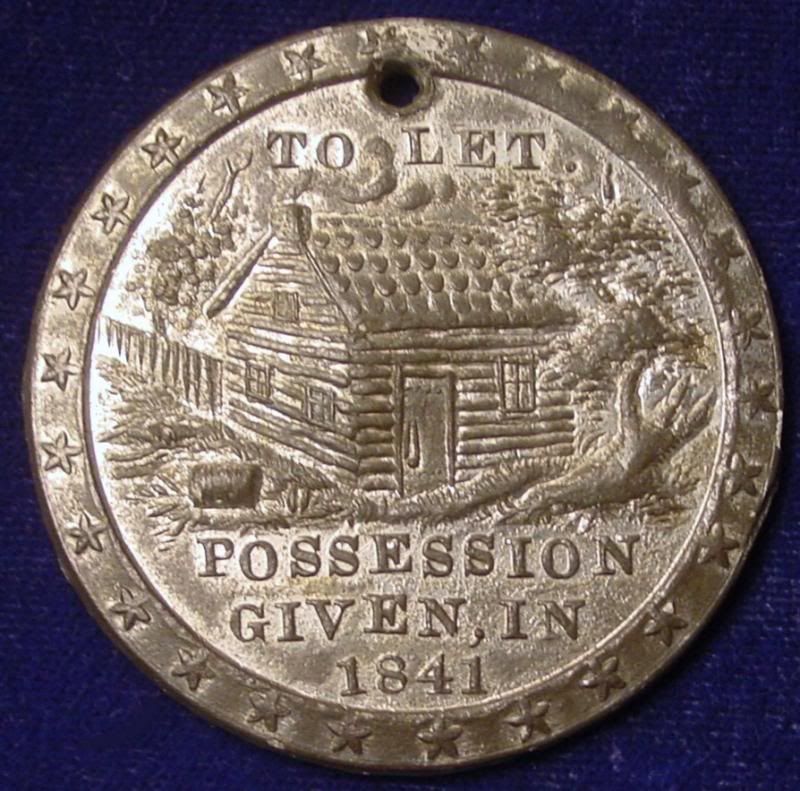
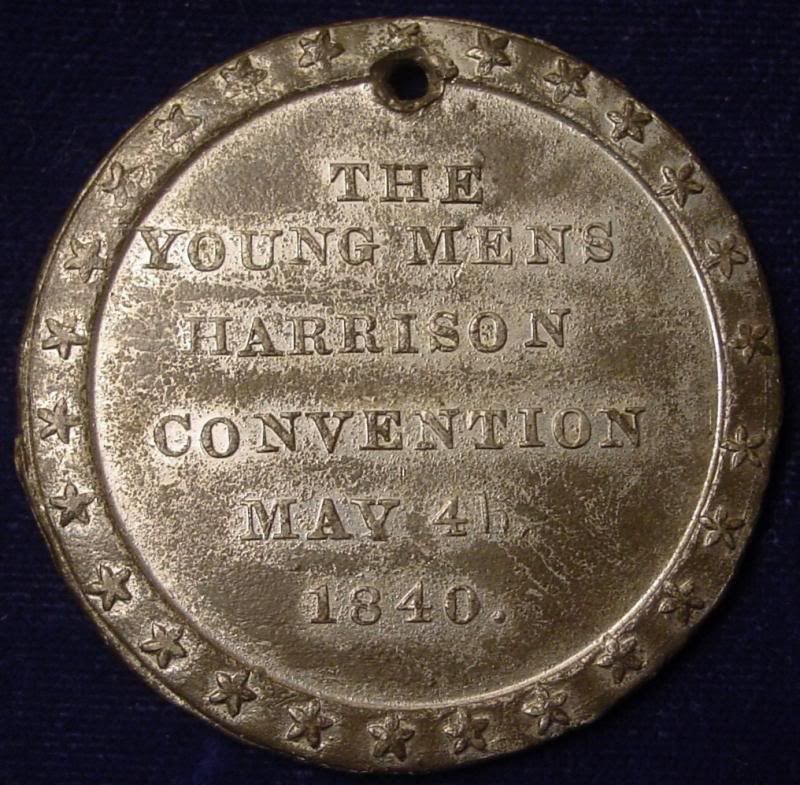
-
Here is a jump to another denomination using the same date move.
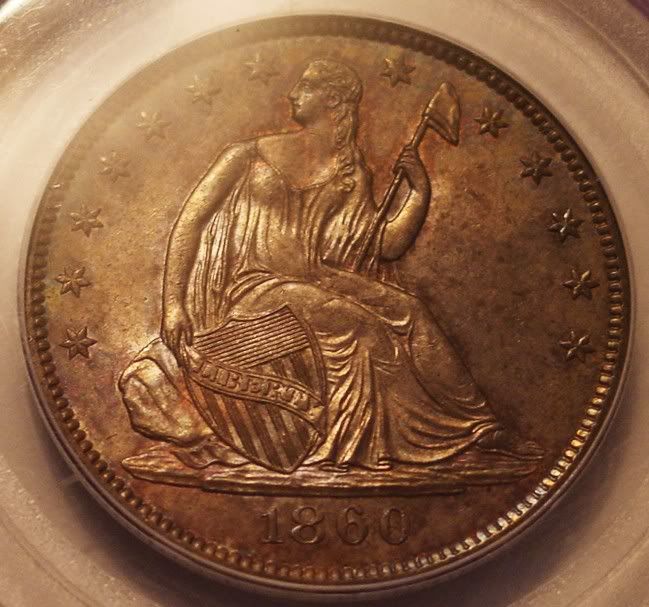
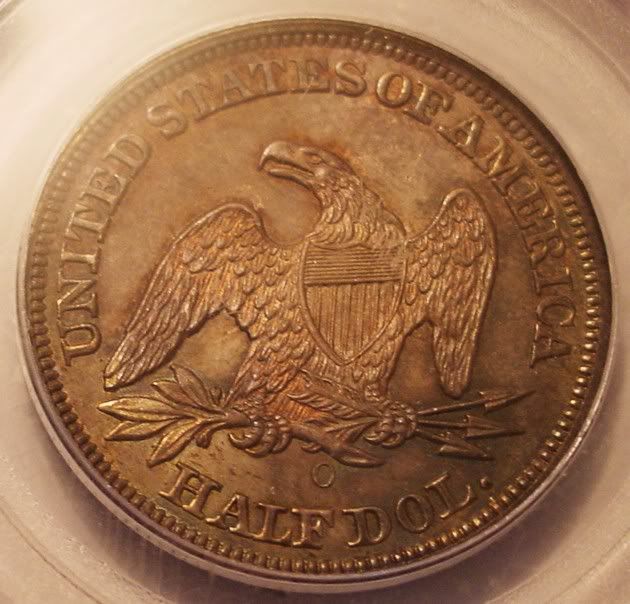
-
Given the size of the photos I can't say this with 100% accuracy, but it does not look good. The surfaces appear to the grainy texture of the usual cast counterfeit. Don't feel badly. Most proposed examples of this coin are not good. At any rate you would have to send this to NGC or PCGS to be certified to sell it for a fair amount of money. The raw ones (uncertified) don't cut it because there are so many copies.
I'll defer to the others, but I'm sorry I can't be more positive.
-
I don't own an 1804 dollar (
 NOT), but here is an 1802 which is the same general type. The piece you posted in your photo only resembles the real thing.
NOT), but here is an 1802 which is the same general type. The piece you posted in your photo only resembles the real thing. 
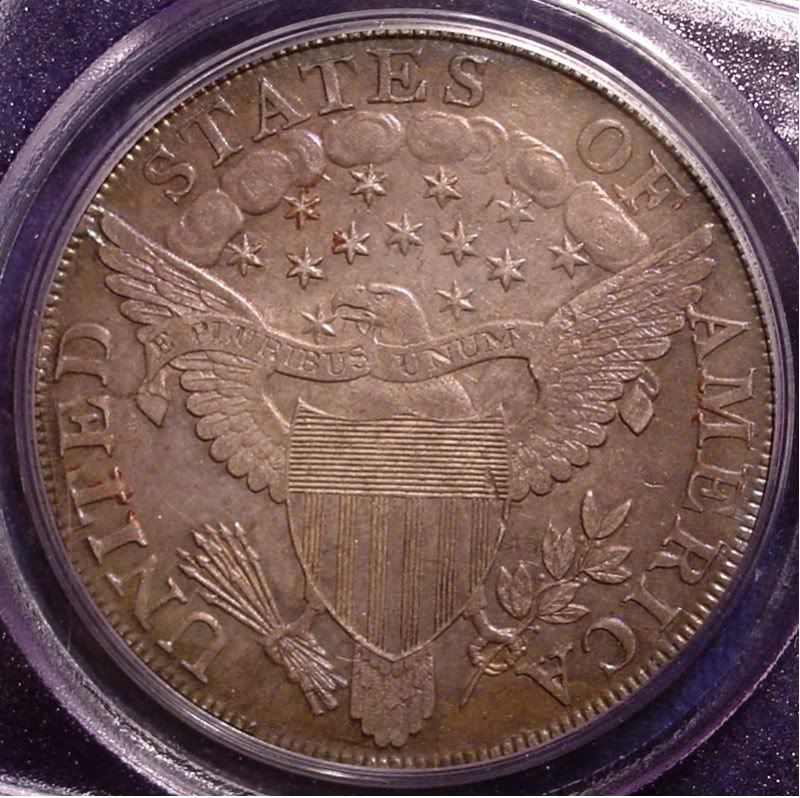
The date is too big, and the design devices are too small on the item you posted.
The location of all of the 15 known 1804 silver dollars are known. Back in the 1960's and 1970s, two pieces went missing after they were stolen from the du Pont collection. They have since been recovered.
The 1804 dollars have had little to do with Iran. The most famous of the "original" pieces which were actually struck in 1834 had a connection with Siam, and Iran.
-
I'm sorry, but I can't make a link to the picture coded in your post.
Here is a genuine 1795 Bust dollar is that is any help.
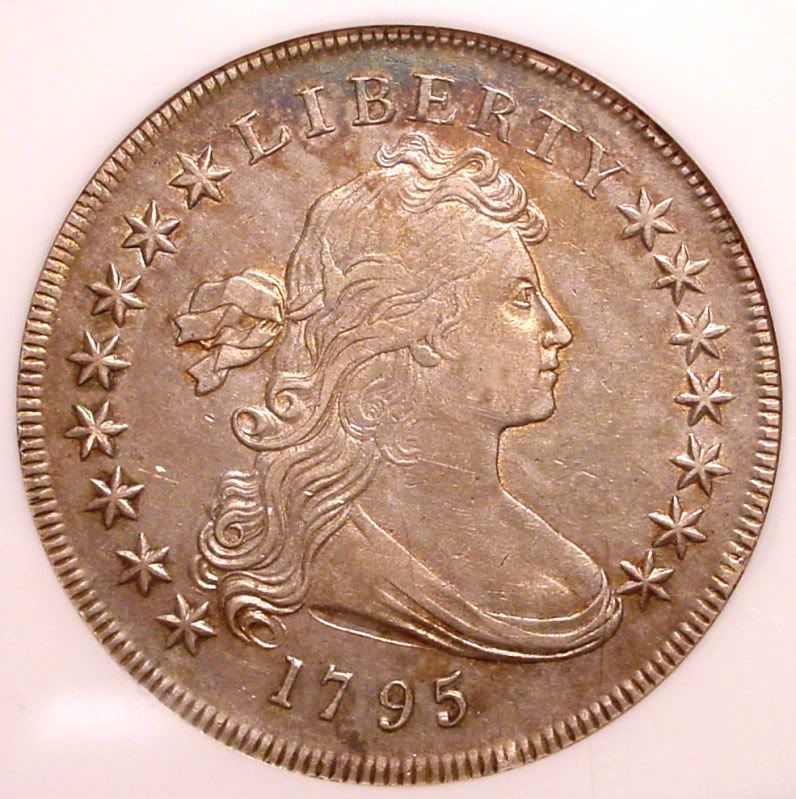

The more common of the two varieties of 1795 Bust dollars has the positioned too far to the right. This is the "centered" variety.
-
I just received these pieces from the last Baltimore Stacks - Bowers auction, an 1875-CC Twenty Cent Piece in NGC MS-62 (Super well struck !!
 ) and an 1801 Bust Dollar in EF-45.
) and an 1801 Bust Dollar in EF-45. 1875-CC Twenty Cent Piece
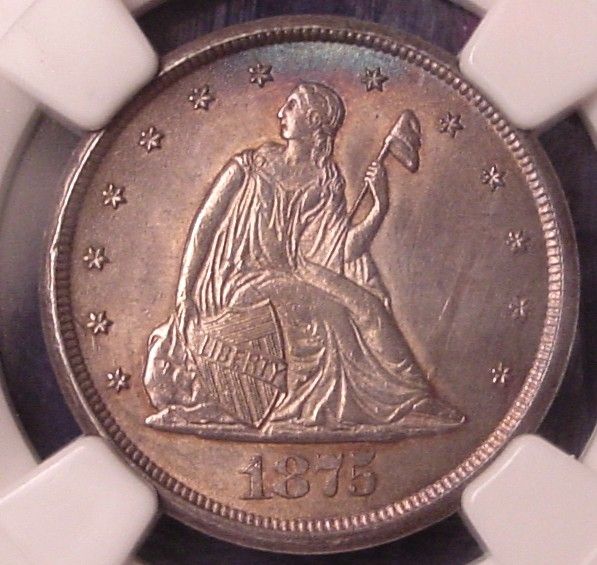
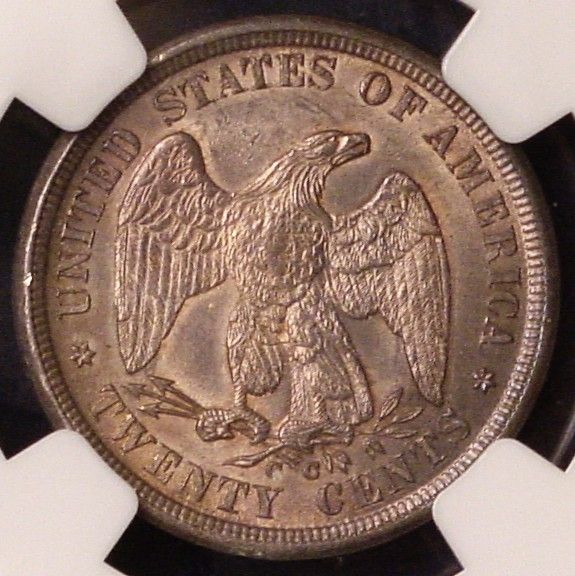
1801 Dollar
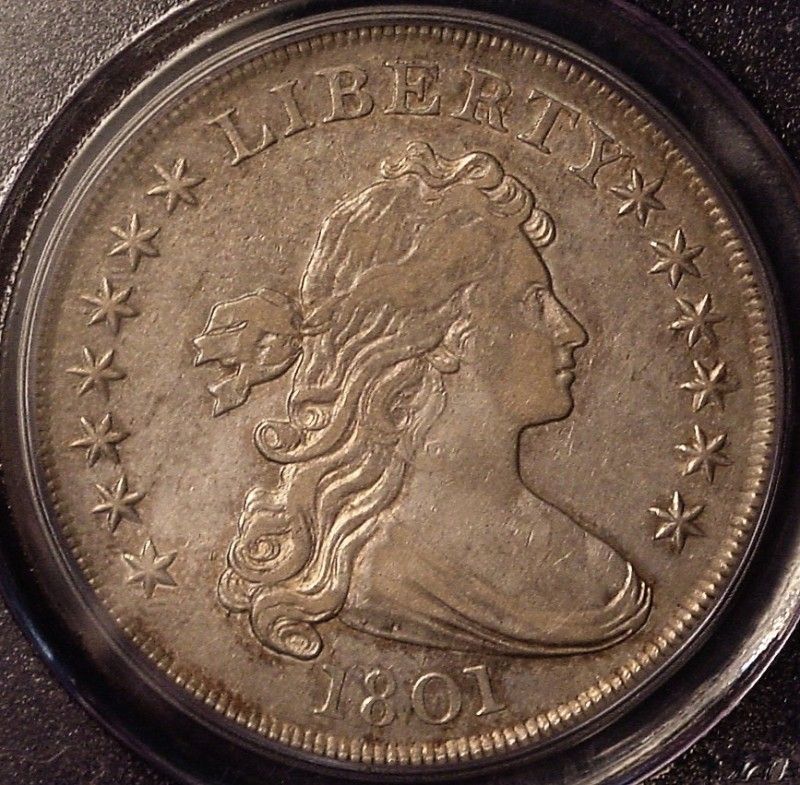

-
When it comes to proof sets directly from the Mint, it's really easy. If it ain't a PF69UCAM, it's a PF70UCAM!
True for very recent sets, but for the earlier sets he is talking about most will grade PF-65 to 67 and most of the coins from the earliest sets probably wouldn't even get a CAM designation unless he specifically selects for it on his submissions. Even then the chances of getting better than a CAM designation is slight at best.
Sadly even that is not true given some of the junk the mint is shipping in Proof sets these days.
When I went to my local dealer to buy a 2012 clad Proof sets, I was appalled at low quality. Most of the Presidential dollars were spotted; there were "holes" in the Proof surfaces in the fields; some of the cents had spots; and a couple coins had small scratches. In other words a goodly number of the coins less than PR-69. They were more like PR-66 or less.
Yesterday I bought my 2012 silver set from the same dealer. This time the quality was much better. There were only a couple coins with spots among the two sets, and one of the quarters had a small but noticeable scratch. Fortunately I was able to put together a nice set.
Still buying Proof sets from the mint is a real throw of the dice these days.
-
If you open these sets it will proably be a double loss. Ordinary sets are traded in the original mint packaging. The best deals for those are the sets with nice boxes and cases. As a collector that what I want. Sets that have been broken out of the holders sell for even less than the depressed prices you get for sets in the holders.
As the slab grades you might get, the sets from the late '60 and the '70s seldom yeild better than PR-67 or 68 coins, and those are worth very little. For the later sets PR-69 coins don't cut it. They are the ones I buy for $20 to complete my registry type set. The dealer witll buy them back for $5.
In other words, with the late date Proof sets, it's PR-70, super DCam or nothing.
-
He said that there is no minimum in Vermont on sales taxes, everything is hit. I think he's wrong. Plus I have a sales and use tax permit so should be exempt. I emailed the state tax department and hope to get clarity from them.
When I was dealer in New England, here were the rules as I knew them by state.
Massachusetts - No sales tax on coin purchases $1,000 and more.
New Hampshire - No sales tax period
Connecticut - No sales tax on U.S. coins period.
Vermont is a very radical state. It would not surprise me if they had sales tax on all purchases.
I only did one show in Maine when I lived in New England, and I can't remember the rules there.
Bullion was taxable, but since the U.S. gold and silver eagles have a face value, they are coins and are treated as such. Bars are another matter.
-
-
-
Bill Jones, being a Georgia Boy myself, I love those Dahlonega coins!!!

MM
Thank you very much! (thumbs u
This is part of my Dahlongega gold coin type set, although it's more than likely that the 1855-D gold dollar could de-rail that project.

-
-
Yep, modern fake and not even close. This is one of those counterfeits you can detect from three feet away.
-
Photos would help, but to be honest I would never buy a Continental Dollar that was not certified by NGC or PCGS. There are just too many copies out there. I’ve known dealers who thought they knew what they were doing in this area who got caught.
I’d also advise you have a very fat checking account. These coins go for five figure prices quite easily, and I’m talking well north of $10,000.
I’d also be careful about the price you pay. A dealer, who thought I’d just dropped off the turnip truck, quoted me over a $150,000 each for two he had that were not Mint State or anything that special so far as the grades went. I didn’t know that I looked to that stupid
 to other people.
to other people. 
-
I think this works ...
A 1913 Proof set ...

-
I bought one in copper for $6 from John Weeks, the African-American exonumia dealer who set up in New Jersey. The last I knew he was still around although older like all of us.
 John must have had 50 of them scattered through out his many books of coins, tokens and other stuf.
John must have had 50 of them scattered through out his many books of coins, tokens and other stuf. I knew these were not made from the original dies, but copies made from the original canceled and rusted dies. For that reason I didn't put much store by them.
It's hard to believe people are paying that much money for these things. Yes, a mintage of 20,000 for the copper is not much by coin standards, but that's huge for a token, especially for a copy of a token.
I remember in the 1970s Dave Bowers advertied the original restrikes in his Rare Coin Review and could not find any takers at three or four thousand dollars.
Who have have thunk it that something like this would bring hundreds of dollars.

-
When comes to market dominance, PCGS leads the field in high grade modern coins by a wide margin. There are at least two reasons for this.
First, I think that the PCGS registry is more prestigious, and since they only allow their product in their registry, you must buy their coins to participate.
Second, PCGS gives out far fewer PR-70s and NGC. This might have something to do with grading standards, but I think that it also has something to do with market control. If you keep the number of available pieces down, the prices will be higher. Therefore PCGS drives up the price of its PR-70 product by limiting the supply.
I have only two PR-70 coins and both are NGC coins. I bought the nickel because I wanted to say I had one PR-70 graded coin. I bought the quarter because it cost only a few dollars more than a PR-69, and I was in the mood to fill the hole. You can judge what you think of them for the grade.
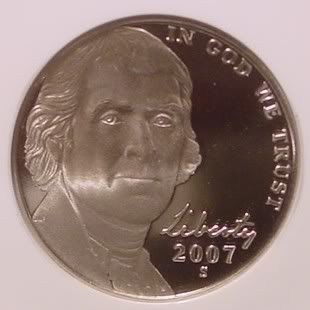
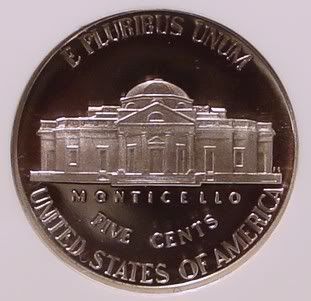


-
This is the first I've heard of this hoard, so I can't add anything. But does someone have pictures of the 69s? Holy cow, those must be amazing.
Having looked at the photos, I'd have to say that I might have a hard time giving that coin an MS-69. I can spot at least three small marks on the obverse that would be visible, at least to me, with the naked eye. To me an MS-69 should have no more than couple of barely perceptable marks. So I guess I would have called an MS-68, but what do I know?

-
From what I understand, the 19,900 coins were purchased in the 1990s, but they were in sealed bags dated from the 1960s. Those bags replaced the original bags from 1917 that had deteriorated. The original hoard had something to do with an international payment from the World War I era, and outside of the rebagging in the 1960s were essentially untouched since 1917. The fact that these were for an international payment was likely how they escaped the great melt of the 1930s. After they were purchased, they were stored for a time at the Wells Fargo bank in Nevada, which is where they got their name.
Here is a breakdown of the grades of this hoard: MS-68 (200+); MS-67 (1,700+); MS-66 (6,000+); the balance were MS-65 and below and there are a few that graded MS-69.
I think you have given us the answer, jtryka. Most of the pre 1933 gold coins that are available to us today were in Europe when the Gold Surrender order was issued. Any gold that was in the hands of the U.S. banks had to be turned in to the government.
As for IRA (Individual Retirement Accounts) those did not start until the late 1970s for bank held accounts, and the early to mid '80s for corporate accounts.
-
The other night I was reading about the Wells Fargo hoard of 1908 No Motto $20 gold pieces in the Encyclopedia of U.S. Gold Coins 1795 - 1933 by Jeff Garrett and Ron Guth. This hoard contained 19,900 double eagles. Many of them were Gem Unc. quality including one that graded PCGS MS-69.
 It was stated that these coins were found in sealed bags that had not been moved for decades. The name came from their temporary storeage place which was a Wells Fargo bank vault.
It was stated that these coins were found in sealed bags that had not been moved for decades. The name came from their temporary storeage place which was a Wells Fargo bank vault. My question is, if these bags were never moved and deep in the vaults of a bank, how did they escape the 1933 Gold Surrender Order? And if they had been held in the bank, how did the bank get away with it? I thought the Roosevelt Administation required that all of these coins had to be turned in for melting.

-




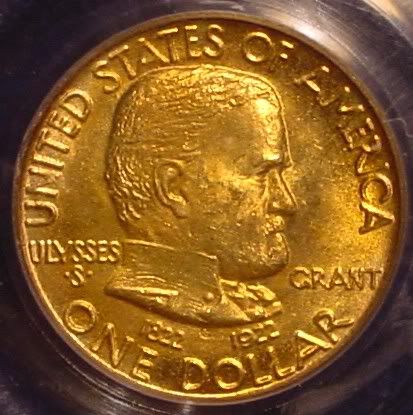
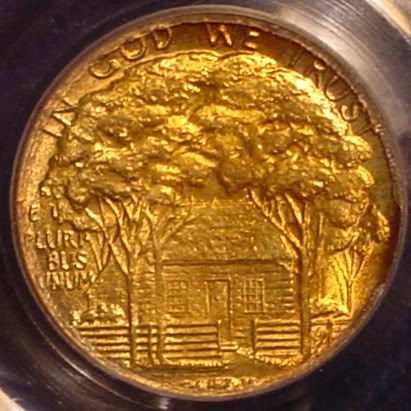

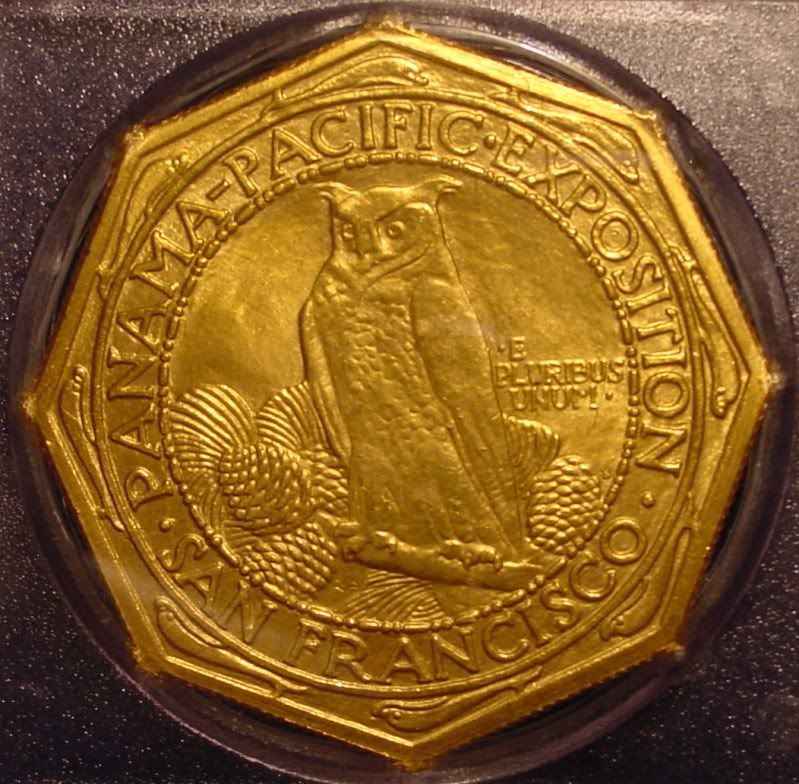
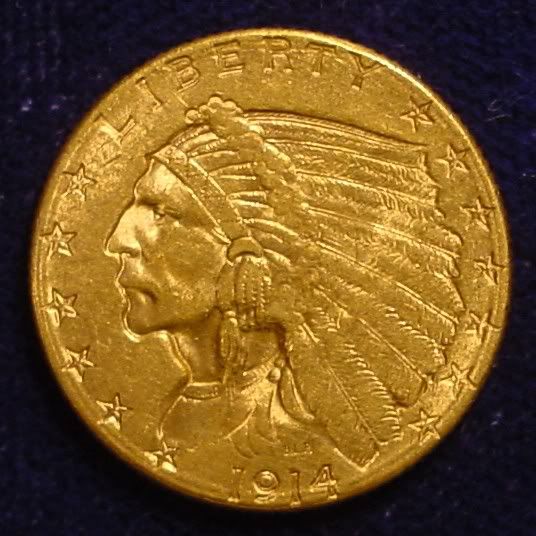

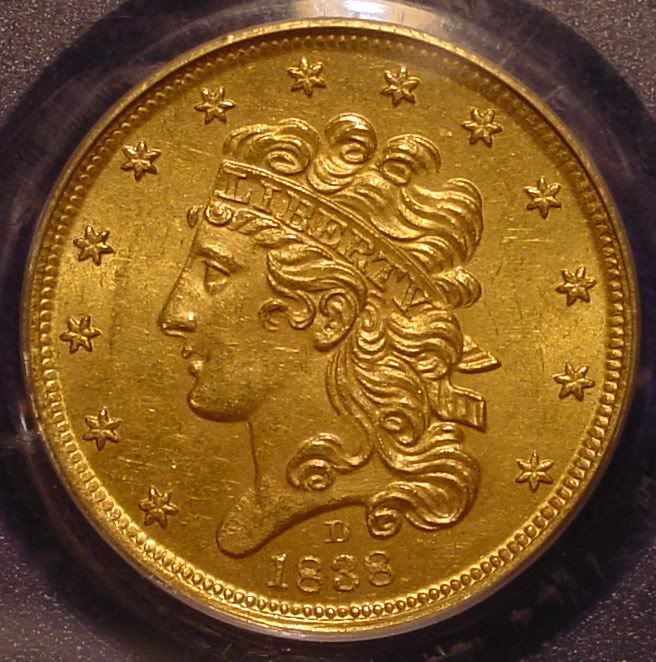
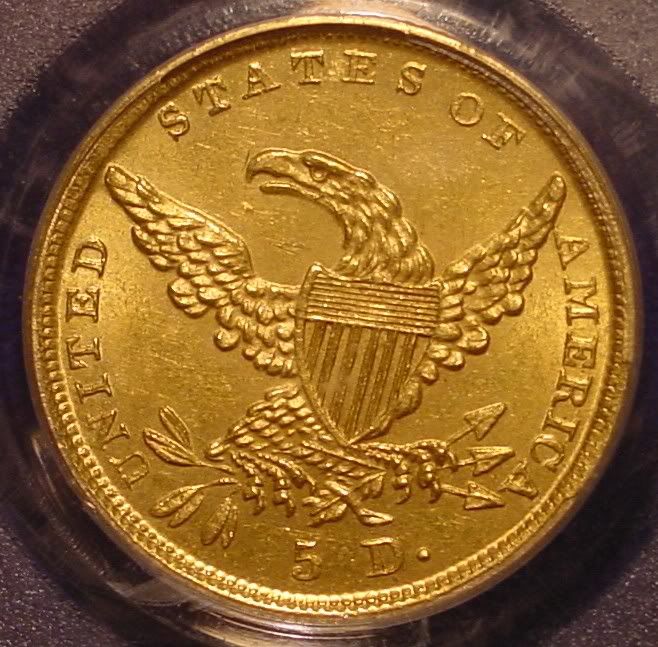
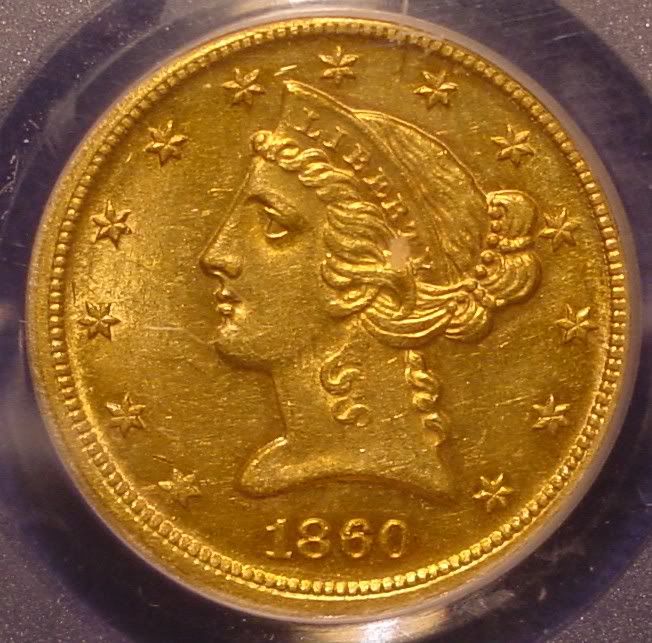
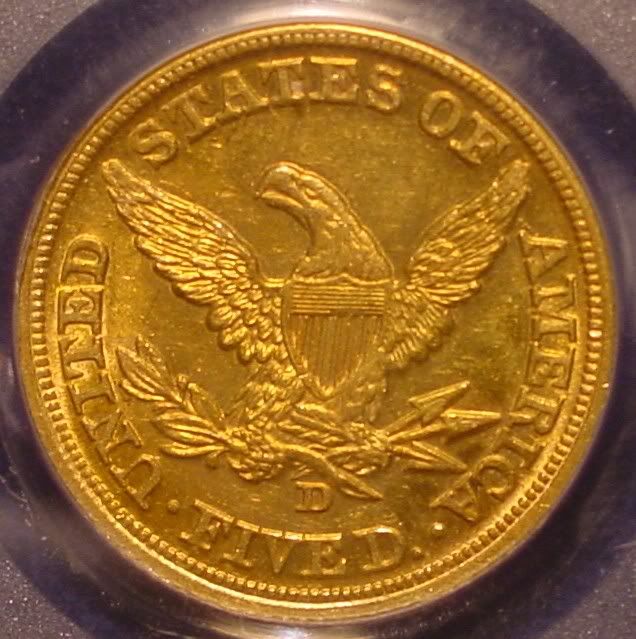
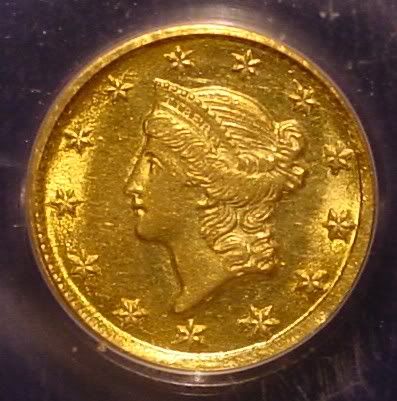
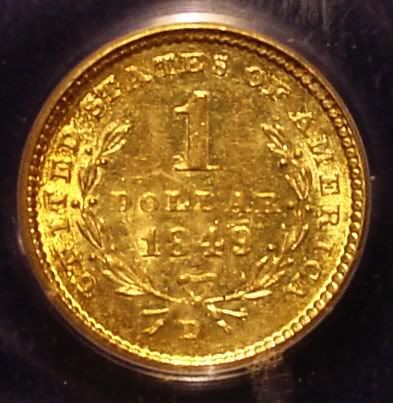
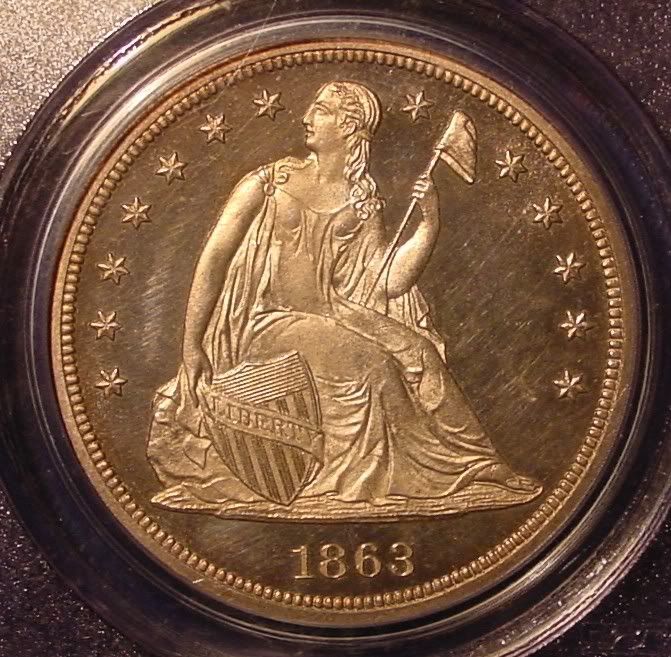

A Rare 1840 William Henry Harrison Campaign Medal
in US, World, and Ancient Coins
Posted
I am of the opinion that a conservative third party would be a disaster for this country. It would divide the conservative movement and open up most of the political spectrum to the so-called "progressives." I believe in freedom and individual responsibility, and I want to work within the system as much as I can.